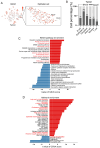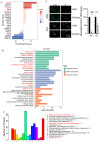Mechanistic insights into promotion of non-small cell lung cancer by BAG5 using integrative multi-omics approaches
- PMID: 40787462
- PMCID: PMC12331601
- DOI: 10.3389/fimmu.2025.1648139
Mechanistic insights into promotion of non-small cell lung cancer by BAG5 using integrative multi-omics approaches
Abstract
Introduction: With the continuous emergence of new technologies in omics, the integrative analysis of multi-omics data has become a new direction to explore life mechanisms. The Bcl-2 associated athanogene (BAG) family consists of co-chaperones involved in various cellular processes, including stress signaling, cell cycle regulation, and tumorigenesis. BAG5, a unique member of this family, contains multiple BAG domains, yet its role in non-small cell lung cancer (NSCLC) remains largely unexplored.
Methods: In this study, we employed a multi-omics approach, integrating single-cell transcriptomics, proteomics, interactomics, and phosphoproteomics data to comprehensively investigate BAG5 function in NSCLC. Functional analyses were performed using cell lines and patient-derived organoids (PDOs) to validate our findings.
Results: Our results demonstrate that BAG5 plays a critical role in the regulation of RNA metabolism, mitochondrial dynamics, and metabolic reprogramming. Additionally, BAG5 is involved in cytoskeletal remodeling and epithelial-to-mesenchymal transition (EMT), contributing to the proliferation and invasion of NSCLC cells.
Discussion: These findings underscore the potential oncogenic role of BAG5 in NSCLC, revealing that it acts through multiple molecular pathways. Our study suggests that targeting BAG5 could be a promising therapeutic strategy for treating NSCLC.
Keywords: BAG5; EMT; NSCLC; metabolic reprogramming; multi-omics.
Copyright © 2025 Huang, Wang, Yuan, Zhang, Li, Zhao, Hao, Yu and Wang.
Conflict of interest statement
The authors declare that the research was conducted in the absence of any commercial or financial relationships that could be construed as a potential conflict of interest.
Figures








Similar articles
-
Integrin αVβ1-activated PYK2 promotes the progression of non-small-cell lung cancer via the STAT3-VGF axis.Cell Commun Signal. 2024 Jun 6;22(1):313. doi: 10.1186/s12964-024-01639-1. Cell Commun Signal. 2024. PMID: 38844957 Free PMC article.
-
USP15 Drives NSCLC Progression and Chemoresistance, Potentially via Regulation of the U2-Type Spliceosomal Complex.Cancer Med. 2025 Aug;14(15):e71055. doi: 10.1002/cam4.71055. Cancer Med. 2025. PMID: 40762380 Free PMC article.
-
A novel mechanism for A-to-I RNA-edited CYP1A1 in promoting cancer progression in NSCLC.Cell Mol Biol Lett. 2025 Apr 2;30(1):40. doi: 10.1186/s11658-025-00718-6. Cell Mol Biol Lett. 2025. PMID: 40175891 Free PMC article.
-
PET-CT for assessing mediastinal lymph node involvement in patients with suspected resectable non-small cell lung cancer.Cochrane Database Syst Rev. 2014 Nov 13;2014(11):CD009519. doi: 10.1002/14651858.CD009519.pub2. Cochrane Database Syst Rev. 2014. PMID: 25393718 Free PMC article.
-
A rapid and systematic review of the clinical effectiveness and cost-effectiveness of paclitaxel, docetaxel, gemcitabine and vinorelbine in non-small-cell lung cancer.Health Technol Assess. 2001;5(32):1-195. doi: 10.3310/hta5320. Health Technol Assess. 2001. PMID: 12065068
References
MeSH terms
LinkOut - more resources
Full Text Sources
Medical

